seats FIAT DOBLO COMBI 2012 Owner handbook (in English)
[x] Cancel search | Manufacturer: FIAT, Model Year: 2012, Model line: DOBLO COMBI, Model: FIAT DOBLO COMBI 2012Pages: 283, PDF Size: 6.31 MB
Page 104 of 283
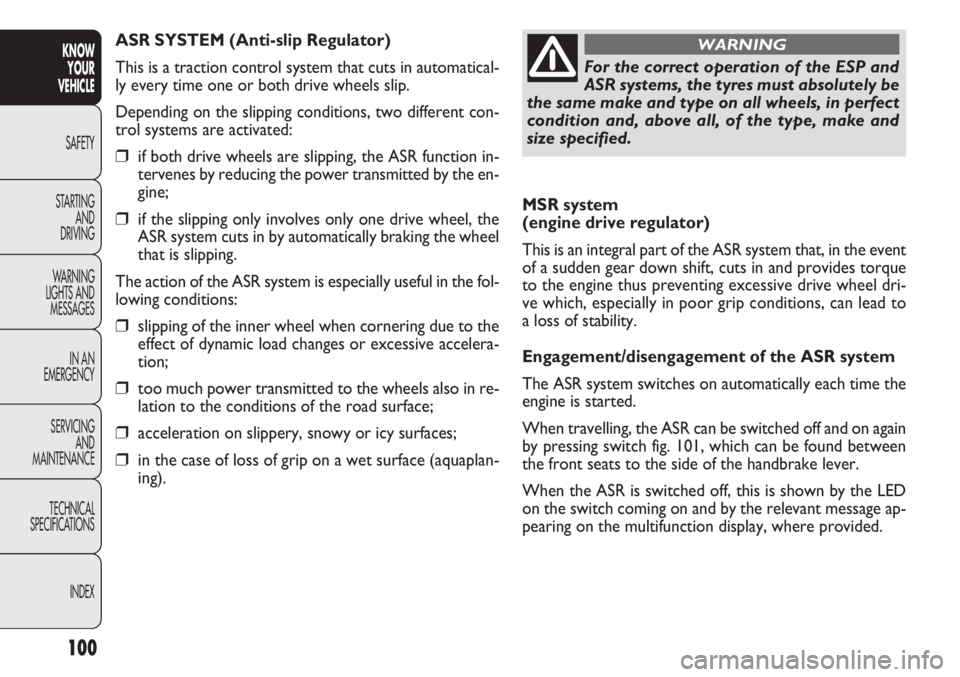
100
KNOWYOUR
VEHICLE
SAFETY
ST AR
TING AND
DRIVING
WARNING
LIGHTS AND MESSAGES
IN AN
EMERGENCY
SERVICING AND
MAINTENANCE
TECHNICAL
SPECIFICATIONS
INDEX
MSR system
(engine drive regulator)
This is an integral part of the ASR system that, in the event
of a sudden gear down shift, cuts in and provides torque
to the engine thus preventing excessive drive wheel dri-
ve which, especially in poor grip conditions, can lead to
a loss of stability.
Engagement/disengagement of the ASR system
The ASR system switches on automatically each time the
engine is started.
When travelling, the ASR can be switched off and on again
by pressing switch fig. 101, which can be found between
the front seats to the side of the handbrake lever.
When the ASR is switched off, this is shown by the LED
on the switch coming on and by the relevant message ap-
pearing on the multifunction display, where provided.
ASR SYSTEM (Anti-slip Regulator)
This is a traction control system that cuts in automatical-
ly every time one or both drive wheels slip.
Depending on the slipping conditions, two different con-
trol systems are activated:
❒if both drive wheels are slipping, the ASR function in-
tervenes by reducing the power transmitted by the en-
gine;
❒if the slipping only involves only one drive wheel, the
ASR system cuts in by automatically braking the wheel
that is slipping.
The action of the ASR system is especially useful in the fol-
lowing conditions:
❒slipping of the inner wheel when cornering due to the
effect of dynamic load changes or excessive accelera-
tion;
❒too much power transmitted to the wheels also in re-
lation to the conditions of the road surface;
❒acceleration on slippery, snowy or icy surfaces;
❒in the case of loss of grip on a wet surface (aquaplan-
ing).
For the correct operation of the ESP and
ASR systems, the tyres must absolutely be
the same make and type on all wheels, in perfect
condition and, above all, of the type, make and
size specified.
WARNING
Page 119 of 283
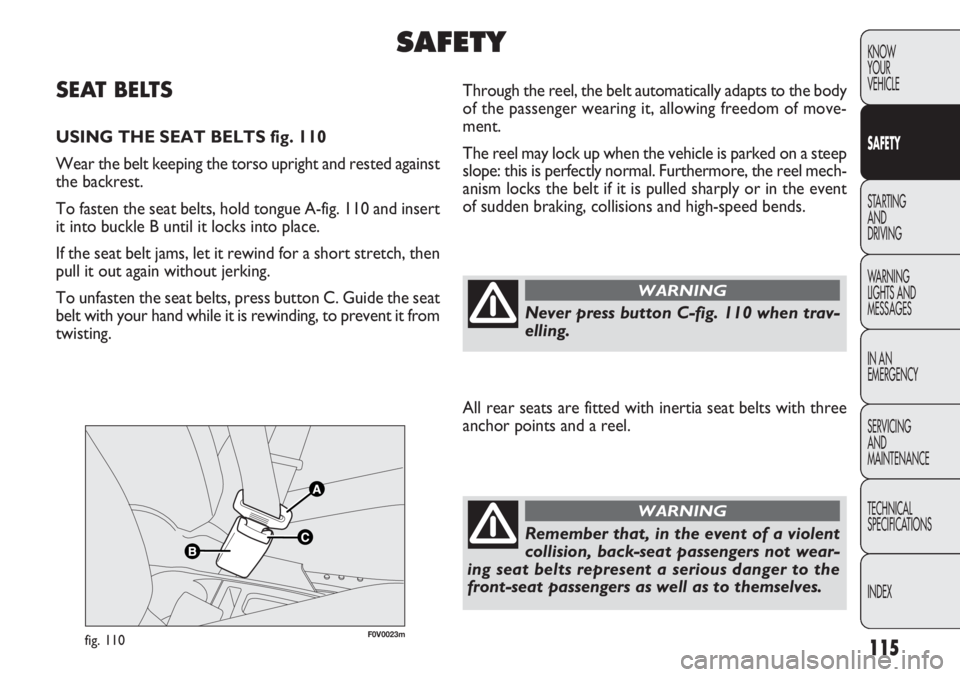
115
KNOW
YOUR
VEHICLE
SAFETY
STARTING
AND
DRIVING
WARNING
LIGHTS AND
MESSAGES
IN AN
EMERGENCY
SERVICING
AND
MAINTENANCE
TECHNICAL
SPECIFICA
TIONS
INDEX
F0V0023mfig. 110
Through the reel, the belt automatically adapts to the body
of the passenger wearing it, allowing freedom of move-
ment.
The reel may lock up when the vehicle is parked on a steep
slope: this is perfectly normal. Furthermore, the reel mech-
anism locks the belt if it is pulled sharply or in the event
of sudden braking, collisions and high-speed bends.SEAT BELT S
USING THE SEAT BELTS fig. 110
Wear the belt keeping the torso upright and rested against
the backrest.
To fasten the seat belts, hold tongue A-fig. 110 and insert
it into buckle B until it locks into place.
If the seat belt jams, let it rewind for a short stretch, then
pull it out again without jerking.
To unfasten the seat belts, press button C. Guide the seat
belt with your hand while it is rewinding, to prevent it from
twisting.
SAFETY
Never press button C-fig. 110 when trav-
elling.
WARNING
All rear seats are fitted with inertia seat belts with three
anchor points and a reel.
Remember that, in the event of a violent
collision, back-seat passengers not wear-
ing seat belts represent a serious danger to the
front-seat passengers as well as to themselves.
WARNING
Page 120 of 283
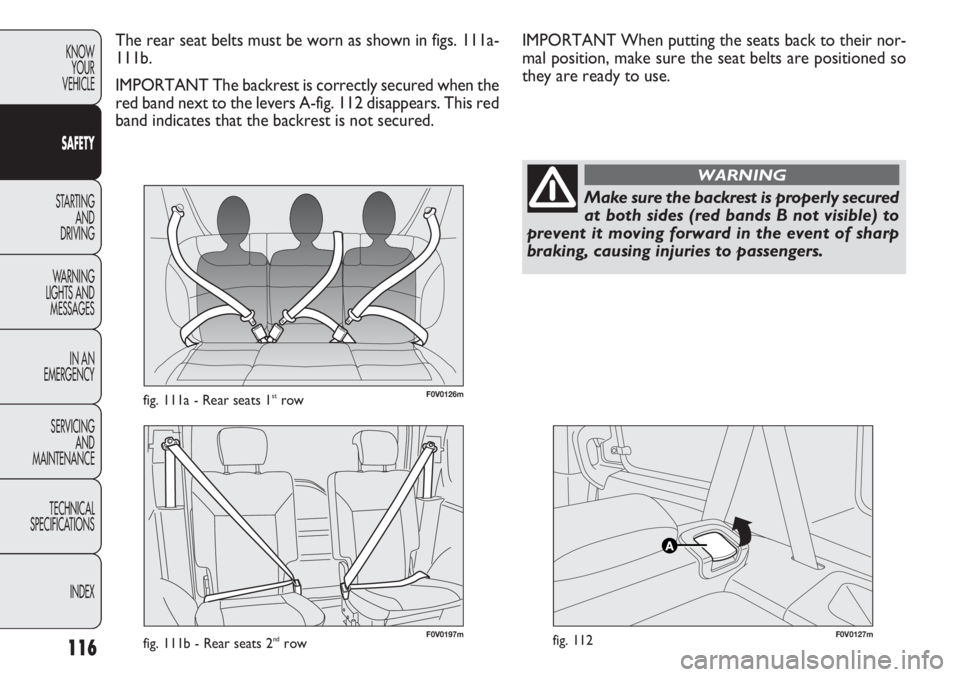
116
KNOWYOUR
VEHICLE
SAFETY
STARTING AND
DRIVING
W ARNING
LIGHTS AND MESSAGES
IN AN
EMERGENCY
SERVICING AND
MAINTENANCE
TECHNICAL
SPECIFICA
TIONSINDEX
F0V0126mfig. 111a - Rear seats 1strow
F0V0127mfig. 112
The rear seat belts must be worn as shown in figs. 111a-
111b.
IMPORTANT The backrest is correctly secured when the
red band next to the levers A-fig. 112 disappears. This red
band indicates that the backrest is not secured.
Make sure the backrest is properly secured
at both sides (red bands B not visible) to
prevent it moving forward in the event of sharp
braking, causing injuries to passengers.
WARNING
IMPORTANT When putting the seats back to their nor-
mal position, make sure the seat belts are positioned so
they are ready to use.
F0V0197mfig. 111b - Rear seats 2ndrow
Page 123 of 283
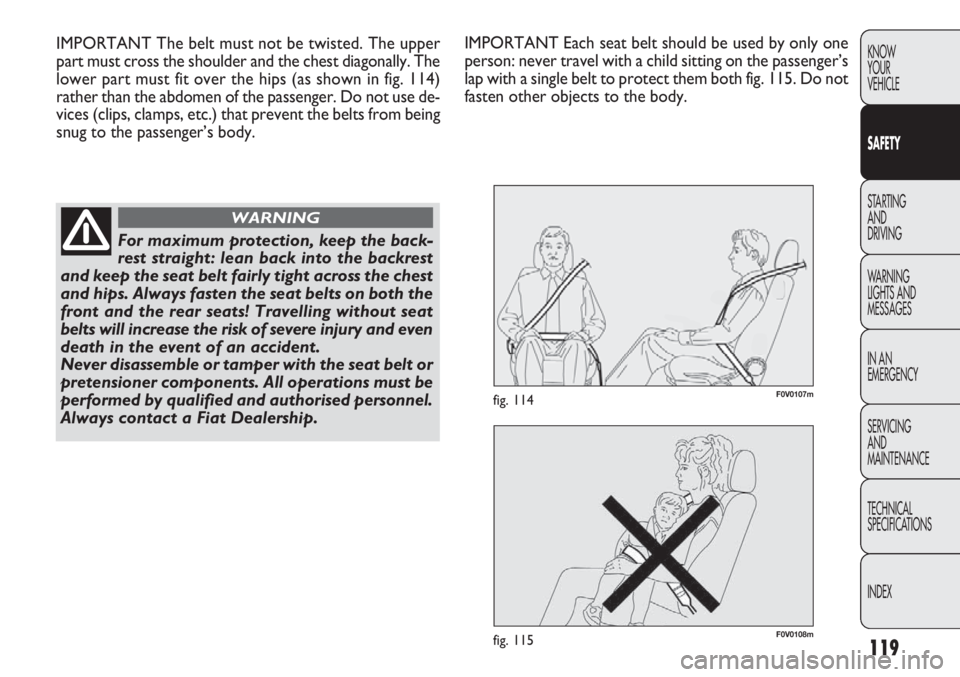
119
KNOW
YOUR
VEHICLE
SAFETY
STARTING
AND
DRIVING
WARNING
LIGHTS AND
MESSAGES
IN AN
EMERGENCY
SERVICING
AND
MAINTENANCE
TECHNICAL
SPECIFICA
TIONS
INDEX
F0V0108mfig. 115
F0V0107mfig. 114
IMPORTANT The belt must not be twisted. The upper
part must cross the shoulder and the chest diagonally. The
lower part must fit over the hips (as shown in fig. 114)
rather than the abdomen of the passenger. Do not use de-
vices (clips, clamps, etc.) that prevent the belts from being
snug to the passenger’s body.
For maximum protection, keep the back-
rest straight: lean back into the backrest
and keep the seat belt fairly tight across the chest
and hips. Always fasten the seat belts on both the
front and the rear seats! Travelling without seat
belts will increase the risk of severe injury and even
death in the event of an accident.
Never disassemble or tamper with the seat belt or
pretensioner components. All operations must be
performed by qualified and authorised personnel.
Always contact a Fiat Dealership.
WARNING
IMPORTANT Each seat belt should be used by only one
person: never travel with a child sitting on the passenger’s
lap with a single belt to protect them both fig. 115. Do not
fasten other objects to the body.
Page 125 of 283
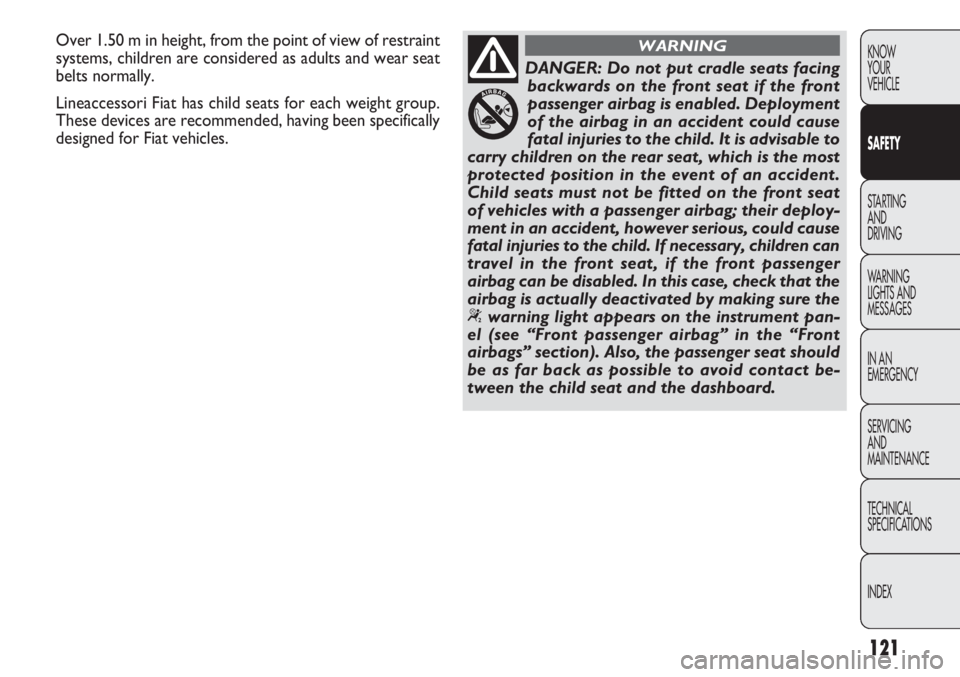
121
KNOW
YOUR
VEHICLE
SAFETY
STARTING
AND
DRIVING
WARNING
LIGHTS AND
MESSAGES
IN AN
EMERGENCY
SERVICING
AND
MAINTENANCE
TECHNICAL
SPECIFICA
TIONS
INDEX
DANGER: Do not put cradle seats facing backwards on the front seat if the front
passenger airbag is enabled. Deployment
of the airbag in an accident could cause
fatal injuries to the child. It is advisable to
carry children on the rear seat, which is the most
protected position in the event of an accident.
Child seats must not be fitted on the front seat
of vehicles with a passenger airbag; their deploy-
ment in an accident, however serious, could cause
fatal injuries to the child. If necessary, children can
travel in the front seat, if the front passenger
airbag can be disabled. In this case, check that the
airbag is actually deactivated by making sure the
“ warning light appears on the instrument pan-
el (see “Front passenger airbag” in the “Front
airbags” section). Also, the passenger seat should
be as far back as possible to avoid contact be-
tween the child seat and the dashboard.
WARNINGOver 1.50 m in height, from the point of view of restraint
systems, children are considered as adults and wear seat
belts normally.
Lineaccessori Fiat has child seats for each weight group.
These devices are recommended, having been specifically
designed for Fiat vehicles.
Page 126 of 283
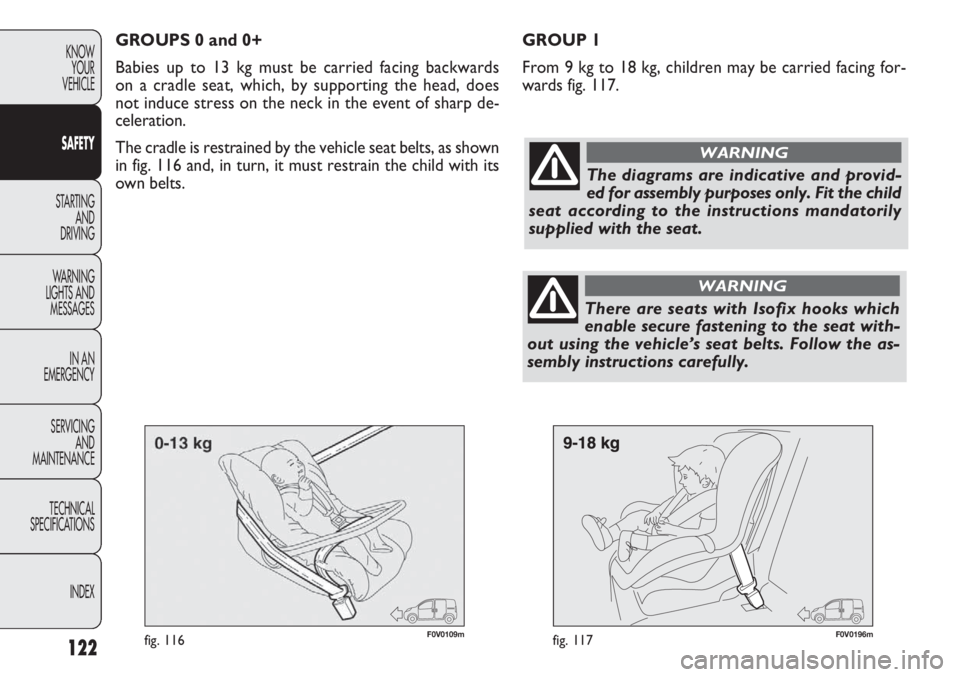
122
KNOWYOUR
VEHICLE
SAFETY
STARTING AND
DRIVING
W ARNING
LIGHTS AND MESSAGES
IN AN
EMERGENCY
SERVICING AND
MAINTENANCE
TECHNICAL
SPECIFICA
TIONSINDEX
F0V0109mfig. 116F0V0196mfig. 117
GROUP 1
From 9 kg to 18 kg, children may be carried facing for-
wards fig. 117.
GROUPS 0 and 0+
Babies up to 13 kg must be carried facing backwards
on a cradle seat, which, by supporting the head, does
not induce stress on the neck in the event of sharp de-
celeration.
The cradle is restrained by the vehicle seat belts, as shown
in fig. 116 and, in turn, it must restrain the child with its
own belts.
The diagrams are indicative and provid-
ed for assembly purposes only. Fit the child
seat according to the instructions mandatorily
supplied with the seat.
WARNING
There are seats with Isofix hooks which
enable secure fastening to the seat with-
out using the vehicle’s seat belts. Follow the as-
sembly instructions carefully.
WARNING
Page 128 of 283
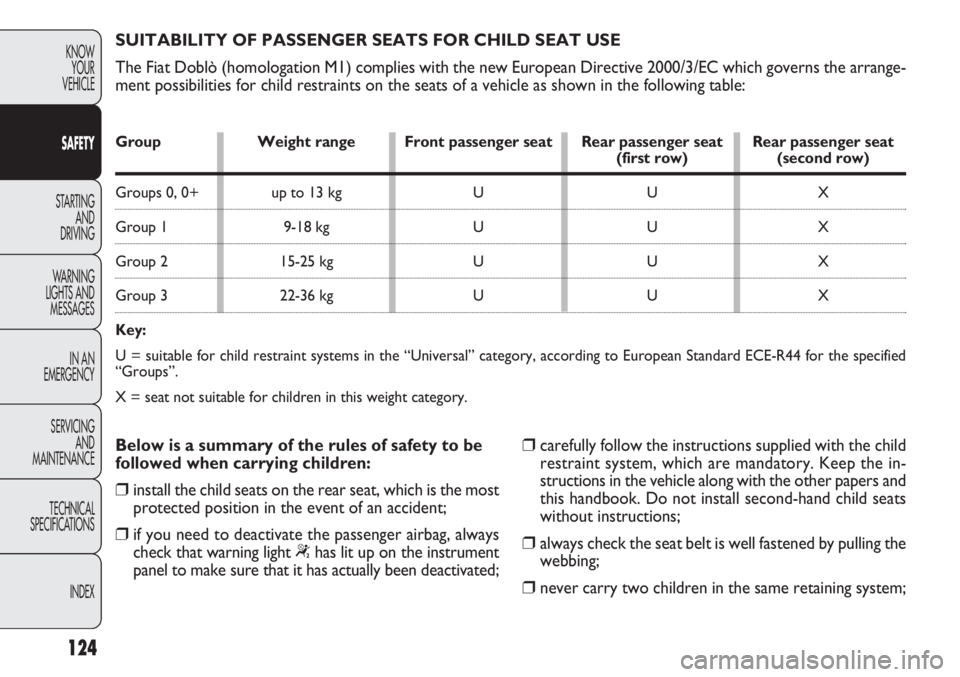
124
KNOWYOUR
VEHICLE
SAFETY
STARTING AND
DRIVING
W ARNING
LIGHTS AND MESSAGES
IN AN
EMERGENCY
SERVICING AND
MAINTENANCE
TECHNICAL
SPECIFICA
TIONSINDEX
SUITABILITY OF PASSENGER SEATS FOR CHILD SEAT USE
The Fiat Doblò (homologation M1) complies with the new European Dir\
ective 2000/3/EC which governs the arrange-
ment possibilities for child restraints on the seats of a vehicle as sho\
wn in the following table:
Below is a summary of the rules of safety to be
followed when carrying children:
❒install the child seats on the rear seat, which is the most
protected position in the event of an accident;
❒if you need to deactivate the passenger airbag, always
check that warning light
“has lit up on the instrument
panel to make sure that it has actually been deactivated;
❒carefully follow the instructions supplied with the child
restraint system, which are mandatory. Keep the in-
structions in the vehicle along with the other papers and
this handbook. Do not install second-hand child seats
without instructions;
❒always check the seat belt is well fastened by pulling the
webbing;
❒never carry two children in the same retaining system;
Group Weight range Front passenger seat Rear passenger seat Rear passenger seat(first row) (second row)
Groups 0, 0+ up to 13 kg UUX
Group 19-18 kg UUX
Group 215-25 kg UUX
Group 322-36 kg UUX
Key:
U = suitable for child restraint systems in the “Universal” catego\
ry, according to European Standard ECE-R44 for the specified
“Groups”.
X = seat not suitable for children in this weight category.
Page 129 of 283
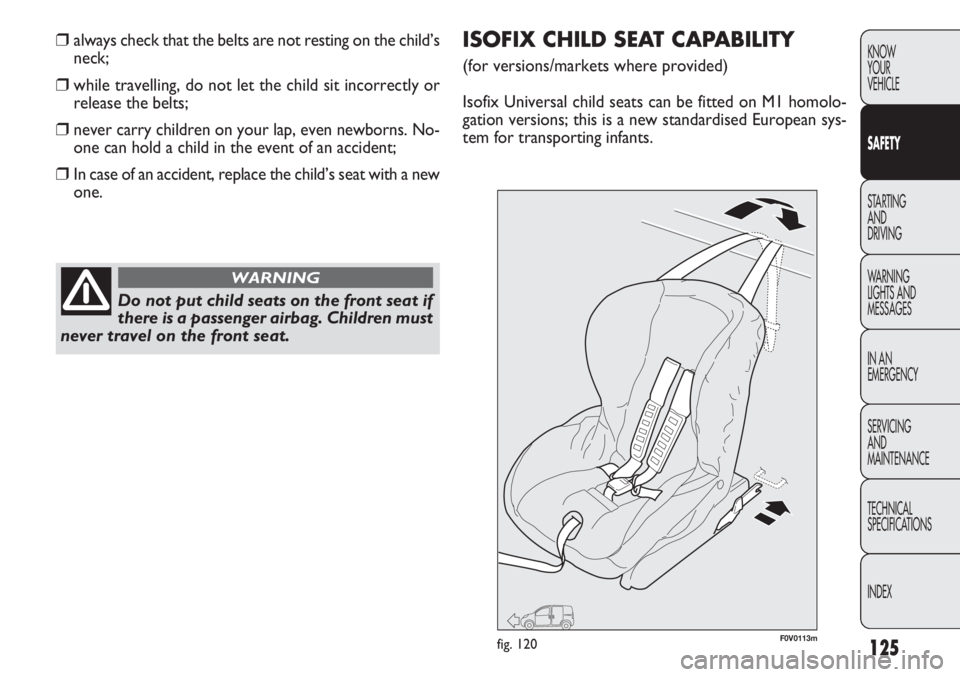
125
KNOW
YOUR
VEHICLE
SAFETY
STARTING
AND
DRIVING
WARNING
LIGHTS AND
MESSAGES
IN AN
EMERGENCY
SERVICING
AND
MAINTENANCE
TECHNICAL
SPECIFICA
TIONS
INDEX
❒always check that the belts are not resting on the child’s
neck;
❒while travelling, do not let the child sit incorrectly or
release the belts;
❒never carry children on your lap, even newborns. No-
one can hold a child in the event of an accident;
❒In case of an accident, replace the child’s seat with a new
one.
Do not put child seats on the front seat if
there is a passenger airbag. Children must
never travel on the front seat.
WARNING
F0V0113mfig. 120
ISOFIX CHILD SEAT CAPABILITY
(for versions/markets where provided)
Isofix Universal child seats can be fitted on M1 homolo-
gation versions; this is a new standardised European sys-
tem for transporting infants.
Page 130 of 283
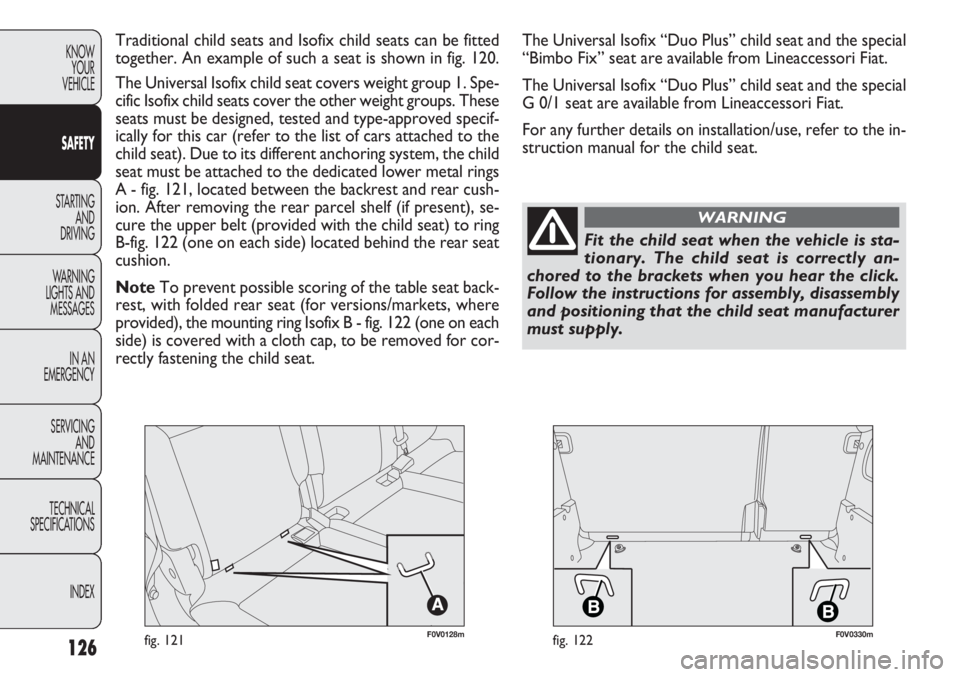
126
KNOWYOUR
VEHICLE
SAFETY
STARTING AND
DRIVING
W ARNING
LIGHTS AND MESSAGES
IN AN
EMERGENCY
SERVICING AND
MAINTENANCE
TECHNICAL
SPECIFICA
TIONSINDEX
F0V0128mfig. 121F0V0330mfig. 122
Traditional child seats and Isofix child seats can be fitted
together. An example of such a seat is shown in fig. 120.
The Universal Isofix child seat covers weight group 1. Spe-
cific Isofix child seats cover the other weight groups. These
seats must be designed, tested and type-approved specif-
ically for this car (refer to the list of cars attached to the
child seat). Due to its different anchoring system, the child
seat must be attached to the dedicated lower metal rings
A - fig. 121, located between the backrest and rear cush-
ion. After removing the rear parcel shelf (if present), se-
cure the upper belt (provided with the child seat) to ring
B-fig. 122 (one on each side) located behind the rear seat
cushion.
Note To prevent possible scoring of the table seat back-
rest, with folded rear seat (for versions/markets, where
provided), the mounting ring Isofix B - fig. 122 (one on each
side) is covered with a cloth cap, to be removed for cor-
rectly fastening the child seat. The Universal Isofix “Duo Plus” child seat and the special
“Bimbo Fix” seat are available from Lineaccessori Fiat.
The Universal Isofix “Duo Plus” child seat and the special
G 0/1 seat are available from Lineaccessori Fiat.
For any further details on installation/use, refer to the in-
struction manual for the child seat.
Fit the child seat when the vehicle is sta-
tionary. The child seat is correctly an-
chored to the brackets when you hear the click.
Follow the instructions for assembly, disassembly
and positioning that the child seat manufacturer
must supply.
WARNING
Page 131 of 283
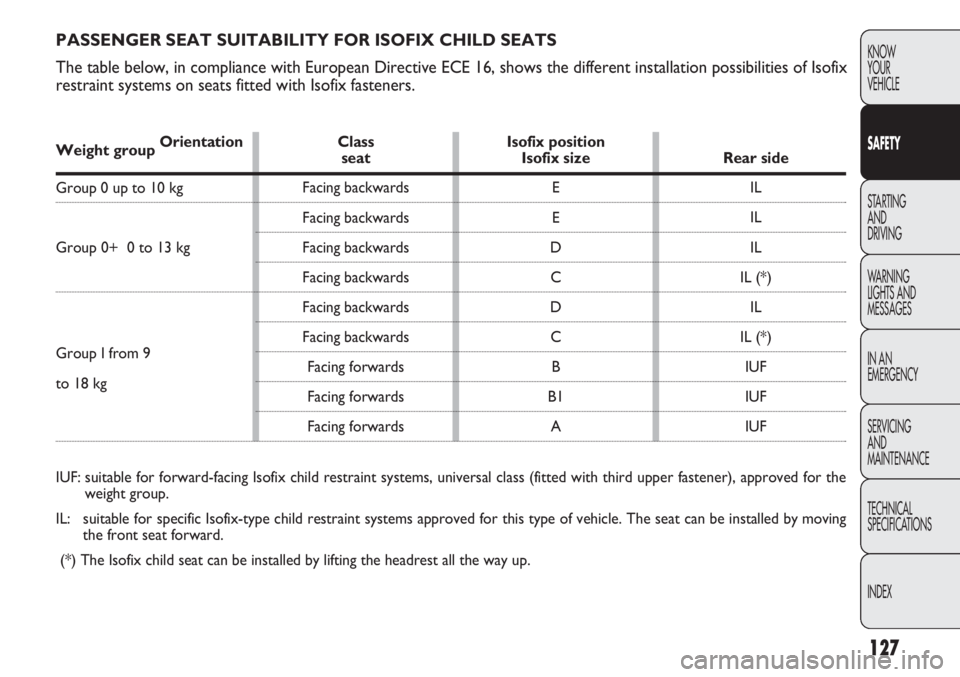
127
KNOW
YOUR
VEHICLE
SAFETY
STARTING
AND
DRIVING
WARNING
LIGHTS AND
MESSAGES
IN AN
EMERGENCY
SERVICING
AND
MAINTENANCE
TECHNICAL
SPECIFICA
TIONS
INDEX
PASSENGER SEAT SUITABILITY FOR ISOFIX CHILD SEATS
The table below, in compliance with European Directive ECE 16, shows the\
different installation possibilities of Isofix
restraint systems on seats fitted with Isofix fasteners.
E
E
D C
D C B
B1 A IL
IL
IL
IL (*) IL
IL (*) IUF
IUF
IUF
Weight group
Orientation Class Isofix position
seat
Isofix size Rear side
Group 0 up to 10 kg
Group 0+ 0 to 13 kg
Group I from 9
to 18 kg
IUF: suitable for forward-facing Isofix child restraint systems, universal cl\
ass (fitted with third upper fastener), approved f or the
weight group.
IL: suitable for specific Isofix-type child restraint systems approved for t\
his type of vehicle. The seat can be installed by moving
the front seat forward.
(*) The Isofix child seat can be installed by lifting the headrest all\
the way up. Facing backwards
Facing backwards
Facing backwards
Facing backwards
Facing backwards
Facing backwards
Facing forwards
Facing forwards
Facing forwards